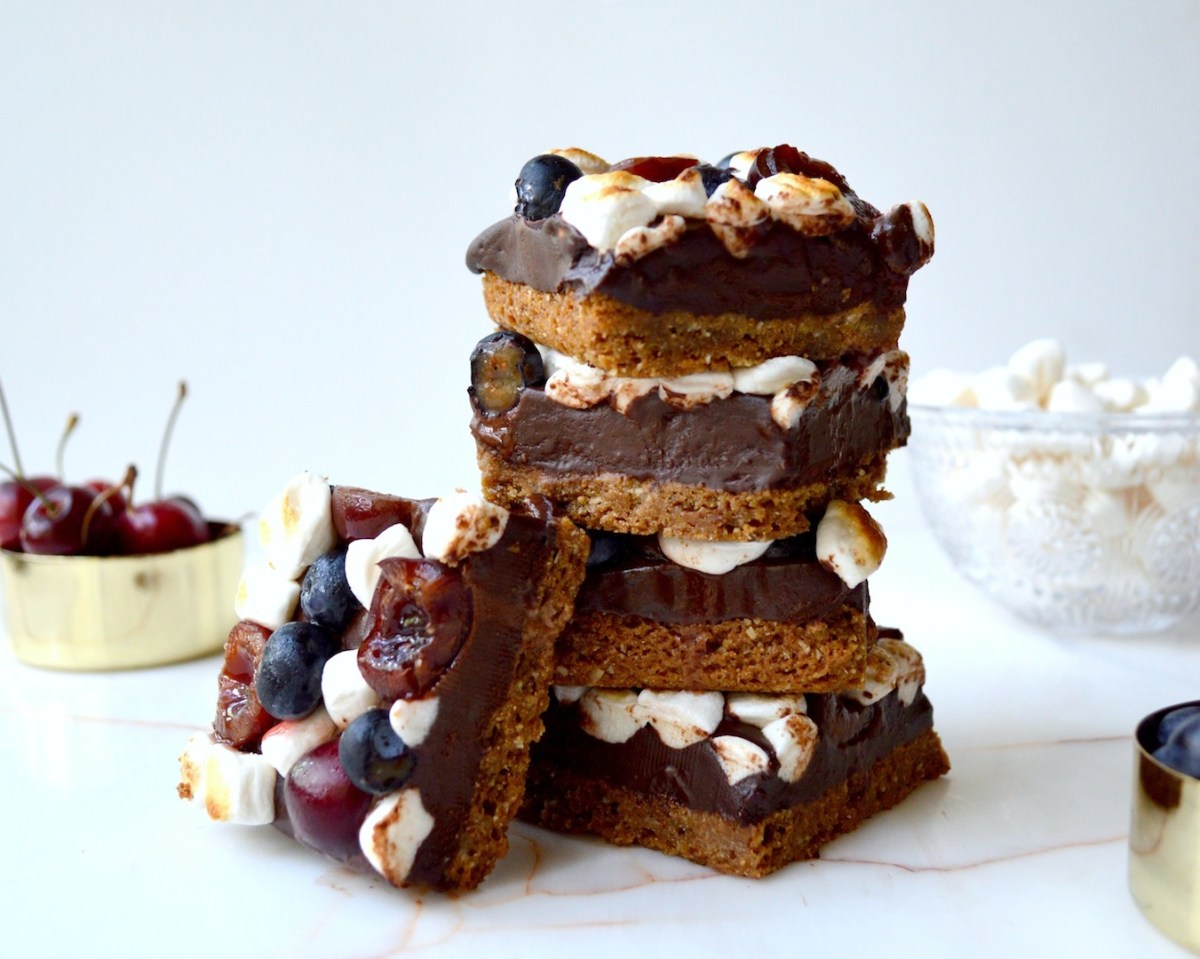Indulge your sweet cravings with a delightful exploration of vegetarian dessert bars! This journey delves into the vibrant world of flavors, textures, and presentations, showcasing a collection of recipes designed to tantalize every taste bud. From classic chocolate to vibrant fruit-filled delights, we’ll uncover the secrets to creating these delectable treats, covering everything from ingredient selection and preparation techniques to stunning visual displays perfect for any occasion. Prepare to be inspired by the endless possibilities of vegetarian baking.
We’ll guide you through step-by-step recipes, offering adaptable options for various dietary needs, including gluten-free and vegan variations. Discover how to elevate your dessert game with creative plating and garnishing techniques, transforming simple bars into edible works of art. Learn how to incorporate seasonal ingredients for a fresh twist, experiment with alternative sweeteners, and master the art of storage and transport, ensuring your creations remain perfect from kitchen to table.
Step-by-Step Recipes for Vegetarian Dessert Bars
These recipes offer a delightful exploration of vegetarian dessert bars, showcasing diverse flavor profiles and adaptable techniques for various dietary needs. Each recipe provides a detailed guide, ensuring a successful baking experience, even for novice bakers. Remember to preheat your oven according to the recipe instructions for optimal results.
Decadent Chocolate Avocado Bars
These rich and fudgy bars belie their healthy ingredient – avocado! The creamy texture of avocado creates a surprisingly decadent chocolate experience, while the addition of dates provides natural sweetness.
Ingredients:
- 1 ripe avocado, mashed
- 1/2 cup unsweetened cocoa powder
- 1/2 cup pitted dates, chopped
- 1/4 cup maple syrup
- 1 teaspoon vanilla extract
- 1/2 cup rolled oats
- 1/4 cup chopped walnuts (optional)
- Pinch of salt
Instructions:
- Preheat oven to 350°F (175°C). Line an 8×8 inch baking pan with parchment paper.
- In a food processor, combine the mashed avocado, cocoa powder, dates, maple syrup, vanilla extract, oats, walnuts (if using), and salt. Process until a smooth, thick batter forms.
- Pour the batter into the prepared pan and spread evenly.
- Bake for 20-25 minutes, or until a toothpick inserted into the center comes out with moist crumbs.
- Let the bars cool completely in the pan before cutting into squares.
Adaptations: For a gluten-free version, ensure your oats are certified gluten-free. For a vegan option, all ingredients are already vegan-friendly.
Zesty Lemon Blueberry Bars
These bars offer a vibrant burst of citrus and berry flavors. The buttery shortbread crust contrasts beautifully with the tangy lemon filling and sweet blueberries.
Ingredients:
- Crust: 1 cup all-purpose flour, 1/2 cup cold unsalted butter (or vegan butter), 1/4 cup powdered sugar, pinch of salt
- Filling: 1 cup blueberries, 1/4 cup lemon juice, 1/4 cup maple syrup, 2 large eggs (or flax eggs for vegan option), 1 tablespoon lemon zest, 1/4 cup all-purpose flour
Instructions:
- Preheat oven to 375°F (190°C). Line an 8×8 inch baking pan with parchment paper.
- Make the crust: Combine flour, butter, powdered sugar, and salt in a bowl. Cut the butter into the flour mixture using a pastry blender or your fingers until it resembles coarse crumbs. Press the mixture into the bottom of the prepared pan.
- Make the filling: In a separate bowl, whisk together blueberries, lemon juice, maple syrup, eggs (or flax eggs), lemon zest, and flour until well combined.
- Pour the filling over the crust and spread evenly.
- Bake for 30-35 minutes, or until the filling is set and the crust is golden brown.
- Let the bars cool completely in the pan before cutting into squares.
Adaptations: For a gluten-free version, use gluten-free all-purpose flour. For a vegan version, replace eggs with flax eggs (1 tablespoon flaxseed meal mixed with 3 tablespoons water per egg).
Peanut Butter and Jelly Bars
A nostalgic twist on a classic combination, these bars feature a crunchy peanut butter base and a sweet, tangy jelly topping. The simplicity of this recipe makes it perfect for beginners.
Ingredients:
- 1 cup peanut butter (or other nut butter)
- 1/2 cup brown sugar
- 1/2 cup rolled oats
- 1/4 cup milk (or plant-based milk)
- 1 cup grape jelly (or other fruit preserves)
Instructions:
- Preheat oven to 350°F (175°C). Line an 8×8 inch baking pan with parchment paper.
- In a bowl, combine peanut butter, brown sugar, oats, and milk. Mix until well combined.
- Press the mixture into the bottom of the prepared pan.
- Spread the grape jelly evenly over the peanut butter mixture.
- Bake for 15-20 minutes, or until the edges are lightly browned.
- Let the bars cool completely in the pan before cutting into squares.
Adaptations: For a gluten-free version, use certified gluten-free rolled oats. For a vegan option, use a vegan peanut butter and plant-based milk.
Creative Presentation and Decoration Ideas
Transforming simple vegetarian dessert bars into visually stunning masterpieces involves thoughtful plating, strategic garnishing, and a keen eye for color, texture, and shape. The right presentation can elevate a delicious treat into a memorable experience, enhancing its appeal and creating a lasting impression. The following sections explore various approaches to achieve this.
Visually Appealing Presentations for Vegetarian Dessert Bars
Three distinct presentations showcase the versatility of vegetarian dessert bars.
- Rustic Elegance: Imagine a dark slate serving board, its cool grey contrasting beautifully with the warm tones of a rich chocolate brownie bar. Slices are arranged artfully, slightly overlapping, with a dusting of powdered sugar creating a delicate snow effect. Fresh raspberries, their vibrant crimson a striking counterpoint, are scattered strategically, adding a juicy pop of color and texture. A sprig of mint adds a touch of freshness and visual interest. This presentation exudes a sense of casual sophistication, perfect for a relaxed gathering.
- Modern Minimalism: A pristine white rectangular platter provides a clean canvas for a vibrant lemon and poppy seed bar. Slices are neatly arranged in a grid pattern, creating a sense of order and precision. A thin drizzle of melted white chocolate, creating delicate lines across the surface, adds a touch of elegance. A few candied lemon peels, their sunny yellow hue complementing the bar, are placed sparingly, avoiding visual clutter. This minimalist approach highlights the bar’s natural beauty and appeals to a modern aesthetic.
- Vibrant Layering: A clear glass pedestal cake stand allows the layers of a layered dessert bar to shine. Imagine a base of a rich, dark chocolate layer, followed by a bright layer of creamy coconut, and topped with a vibrant layer of berry compote. Each layer is carefully cut into squares and stacked, revealing the colorful strata. A dusting of finely grated coconut adds a delicate texture and visual appeal. This presentation is bold and eye-catching, ideal for celebratory occasions.
Creating Visually Stunning Decorations with Natural and Edible Ingredients
Natural and edible ingredients offer a wide array of possibilities for creating visually stunning decorations.
- Fruit Mosaics: Finely sliced fruits like strawberries, blueberries, kiwi, and oranges can be arranged to create beautiful mosaics on top of the bars. The contrasting colors and textures add a vibrant touch.
- Chocolate Drizzles and Shavings: Melted dark, milk, or white chocolate can be drizzled artistically over the bars, creating elegant patterns. Chocolate shavings add a touch of refinement and texture.
- Candied Flowers and Herbs: Candied violets, pansies, or rose petals add a touch of whimsy and elegance. Candied mint leaves or other herbs offer a fragrant and visually appealing element.
- Nut Crumbles and Spreads: Toasted nuts, such as pecans or almonds, can be coarsely chopped and sprinkled over the bars for added texture and visual interest. Nut butters, like peanut butter or almond butter, can be swirled on top for a delicious and visually appealing contrast.
Comparison of Presentation Styles and Suitability for Different Occasions
The choice of presentation style significantly impacts the overall impression.
- Individual Portions: Ideal for events like weddings, formal parties, or upscale catering, where elegance and individual servings are preferred. Miniature bars, elegantly arranged on individual plates, offer a sophisticated touch. Think bite-sized squares on small dessert plates with a delicate garnish.
- Large Slab Presentation: Suitable for casual gatherings, potlucks, or buffets where sharing is encouraged. A large, uncut bar allows guests to serve themselves, fostering a more relaxed and informal atmosphere. This style works well with a rustic or minimalist presentation.
Vegetarian Dessert Bar Variations and Adaptations
The beauty of vegetarian dessert bars lies in their adaptability. By thoughtfully incorporating seasonal ingredients and experimenting with different sweeteners, you can create a constantly evolving array of delicious and visually appealing treats, catering to diverse tastes and preferences. This section explores the exciting possibilities for variation and adaptation, addressing potential challenges and offering practical solutions.
Seasonal Fruit and Vegetable Incorporation
Seasonal produce offers a vibrant palette of flavors and textures that can elevate vegetarian dessert bars to new heights. Using in-season ingredients not only results in superior taste but also supports sustainable practices and reduces environmental impact. For example, imagine the lusciousness of a summer bar infused with juicy raspberries and bright blueberries, contrasted with the comforting warmth of autumnal bars featuring spiced apples and cranberries. The winter months might see the addition of warming spices alongside pears and citrus fruits, while spring could bring a refreshing burst of strawberries, rhubarb, and vibrant citrus zest. Consider the textural interplay: the soft sweetness of roasted butternut squash in a fall bar, the tartness of cranberries providing a counterpoint to the richness of dark chocolate, or the juicy bursts of summer berries against a creamy cashew base.
Alternative Sweeteners and Their Impact
The choice of sweetener significantly impacts both the flavor profile and texture of vegetarian dessert bars. Maple syrup, with its distinct caramel notes, lends a rich, complex sweetness. Agave nectar offers a milder, slightly floral sweetness, but its high fructose content should be considered. Stevia, a natural zero-calorie sweetener, provides intense sweetness with minimal impact on the overall flavor, but can sometimes leave a slightly bitter aftertaste if not used judiciously. For example, a bar sweetened with maple syrup might have a more robust, caramelized flavor, while one sweetened with agave might possess a lighter, fruitier profile. A stevia-sweetened bar would be ideal for those seeking a lower-calorie option, although careful balancing of other ingredients is crucial to avoid a bitter taste. The texture can also be affected; agave can sometimes result in a slightly softer texture, while stevia may require additional binding agents to achieve the desired consistency.
Addressing Challenges in Creating Vegetarian Dessert Bars
One common challenge is achieving the desired texture, often a balance between moistness and firmness. Dryness can be a problem, especially when using alternative sweeteners or incorporating large quantities of dry ingredients like nuts or flour. Solutions include adding moisture-rich ingredients like mashed bananas, applesauce, or silken tofu. These ingredients not only add moisture but also contribute to a richer, denser texture. Another potential challenge is achieving a cohesive structure. Using binding agents like chia seeds, flaxseed meal, or agar-agar can help bind the ingredients together, resulting in a more structurally sound bar that holds its shape well. Finally, ensuring the bars are adequately sweetened without becoming overly sugary requires careful recipe development and testing, especially when using less common sweeteners. Consider the overall flavor balance, adjusting the amount of sweetener based on the other ingredients and the desired level of sweetness.
Serving and Storage Suggestions for Vegetarian Dessert Bars

Maintaining the delightful texture and flavor of your homemade vegetarian dessert bars requires careful attention to both storage and serving. Proper handling ensures your creations remain appealing and delicious, whether enjoyed immediately or saved for later. This guide provides practical advice for maximizing the enjoyment and longevity of your delectable treats.
Ideal Storage Conditions and Shelf Life
Proper storage significantly impacts the shelf life of vegetarian dessert bars. Bars with a higher moisture content, such as those containing fresh fruit or cream cheese frosting, will generally have a shorter shelf life than drier bars like those made with nuts and dried fruits. For optimal freshness, store bars in an airtight container at room temperature for up to 3 days. For longer storage, refrigeration is recommended, extending the shelf life to approximately 5-7 days. Freezing is also a viable option for significantly extending shelf life; wrap bars tightly in plastic wrap, then place them in a freezer-safe container or bag. Frozen bars can maintain their quality for up to 2-3 months. Remember to thaw frozen bars gradually in the refrigerator before serving. Observe the bars closely; discard any showing signs of mold or spoilage.
Serving Suggestions and Accompaniments
Serving vegetarian dessert bars is an opportunity to enhance their appeal and create a memorable culinary experience. The simple act of presentation can elevate these treats from ordinary to extraordinary. Consider cutting the bars into neat, uniform squares or rectangles. Arrange them attractively on a platter or serving tray, perhaps layering them with contrasting colors or textures. Enhance the visual appeal by garnishing with fresh berries, a dusting of powdered sugar, or a drizzle of melted chocolate. Accompaniments can significantly complement the flavors of your bars. A scoop of vanilla ice cream adds a cool, creamy contrast to rich, decadent bars. A dollop of lightly sweetened whipped cream provides a light and airy texture. Fresh fruit, such as sliced strawberries or raspberries, offers a vibrant burst of color and flavor. For a more sophisticated touch, consider serving your bars with a fruit coulis or a light custard sauce.
Transporting Vegetarian Dessert Bars for Events
Transporting vegetarian dessert bars to events or gatherings requires careful planning to ensure they arrive in perfect condition. The key is to maintain their temperature and prevent damage during transit. Use sturdy, airtight containers to protect the bars from jostling and crushing. Line the container with parchment paper or wax paper to prevent sticking. For bars with delicate frostings or toppings, consider transporting them upright to minimize the risk of damage. If transporting during warmer weather, use a cooler bag with ice packs to maintain a cool temperature, preventing the bars from melting or becoming soggy. If traveling a significant distance, consider freezing the bars and allowing them to thaw in the refrigerator at the event location. This ensures the bars remain fresh and delicious, even after a long journey.
From the rich depths of chocolate to the bright burst of fruit, the world of vegetarian dessert bars offers a spectrum of sweet sensations waiting to be explored. This culinary adventure has equipped you with the knowledge and inspiration to craft delectable treats that satisfy both your sweet tooth and your commitment to vegetarian cuisine. With a variety of recipes, presentation ideas, and expert tips, you’re now ready to embark on your own baking journey, creating stunning and delicious dessert bars that will impress and delight everyone.
Query Resolution
Can I freeze vegetarian dessert bars?
Yes! Wrap individual bars tightly in plastic wrap and then foil, or use freezer-safe containers. They can be frozen for up to 3 months.
What are some good substitutes for eggs in vegetarian dessert bars?
Applesauce, mashed banana, flax eggs (flaxseed meal mixed with water), or silken tofu can often be used as egg substitutes, depending on the recipe.
How can I make my vegetarian dessert bars more moist?
Adding a bit of extra oil or moisture-rich ingredients like applesauce or yogurt can help prevent dryness. Ensure you don’t overbake the bars.
Can I use different types of nuts in the recipes?
Absolutely! Feel free to experiment with various nuts and seeds based on your preference and dietary needs. Almonds, walnuts, pecans, and sunflower seeds are all great options.


